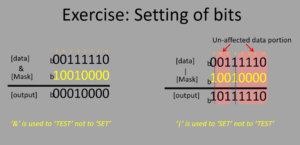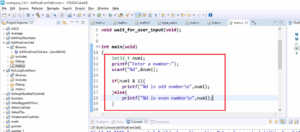while loop exercise
Exercise
Write a program that prints numbers from 1 to 10 using a while loop.
In this exercise, you will practice using a while loop to print numbers from 1 to 10. Below is the code and an analysis of how it works.
Code:
#include <stdio.h>
int main(void)
{
uint8_t num =1;
while(num<=10) {
printf("%d\n", num);
num++;
}
return 0;
}
Explanation:
The program begins in the main function, where a variable num is declared and initialized to 1. num is an unsigned 8-bit integer (uint8_t).
A while loop is used to continue executing as long as the condition num <= 10 remains true. Inside the loop, the printf function is used to display the current value of num on the console, followed by a newline character \n to move to the next line.
After displaying the value of num, it is incremented by 1 using the num++ operator.
The while loop continues to execute until num becomes 11, at which point the condition num <= 10 becomes false, and the loop terminates.
Use the keyword while, then write the expression.
Condition Explanation
What should be the condition here?
Write a program that prints numbers from 1 to 10. So, here until the number is less than or equal to 10. This is the condition or expression.
while(num <= 10);
Analyze the above code
The program’s execution begins with num set to 1. Since 1 is indeed less than or equal to 10, the first number (1) is printed using the printf function. After printing, num is incremented to 2.
Control then returns to the while loop, and the condition is assessed again. As long as num remains less than or equal to 10, the loop continues. This process persists, leading to the printing of subsequent numbers (2, 3, …, 10) and the corresponding incrementation of num .
When num becomes 11, the condition ’11 <= 10′ becomes false. Consequently, the loop body is exited, and the program moves on.
Code Improvement:
Instead of doing the num++ after the printf statement, you can also donum++ in the printf statement. The code is shown below.
int main(void) { uint8_t num =1; while(num<=10) { printf("%d\n", num++); }
Here, num will be printed first, that is 1 will be printed first and then num will be incremented to 2.
Output:
The output shown in Figure 1. Our program indeed printed 1 to 10.

FastBit Embedded Brain Academy Courses
Click here: https://fastbitlab.com/course1



